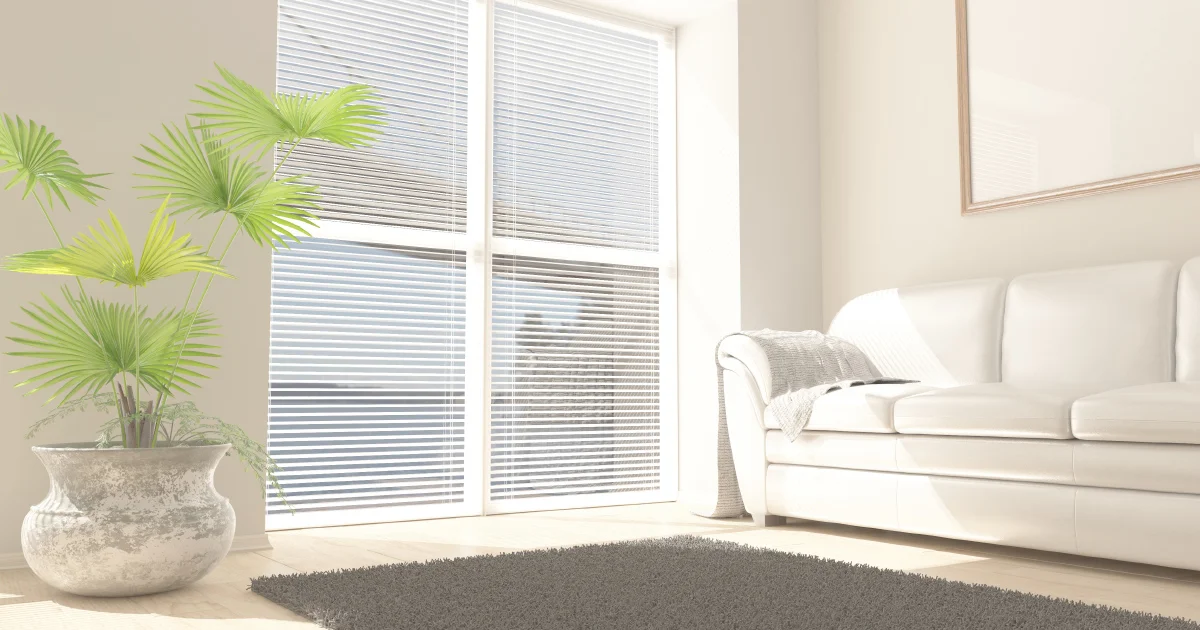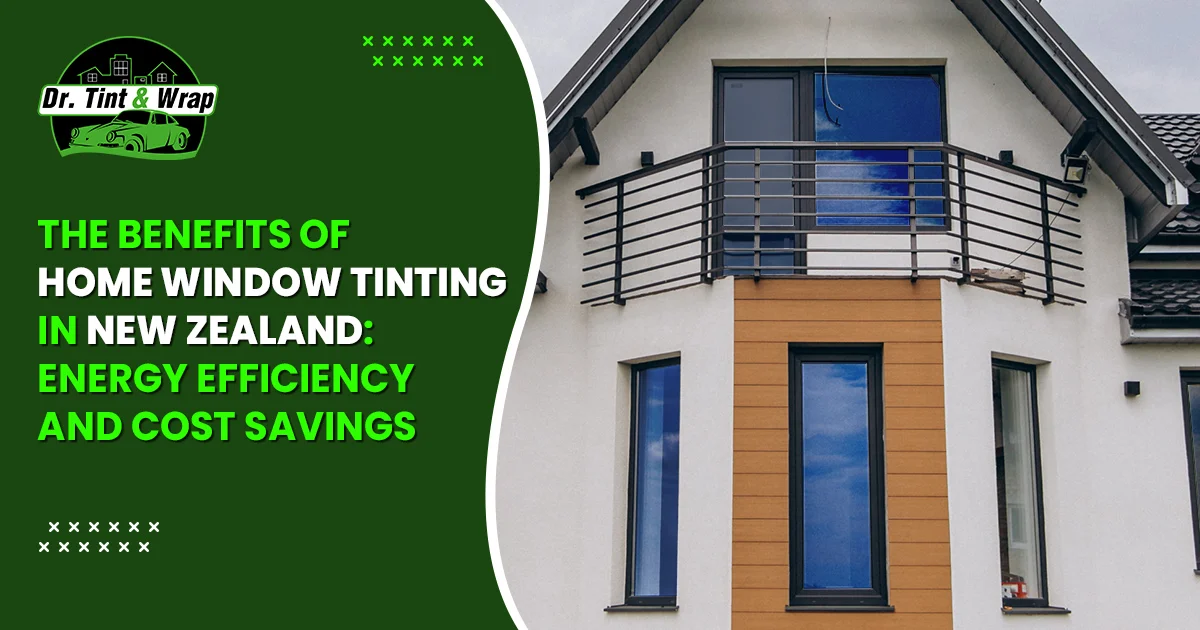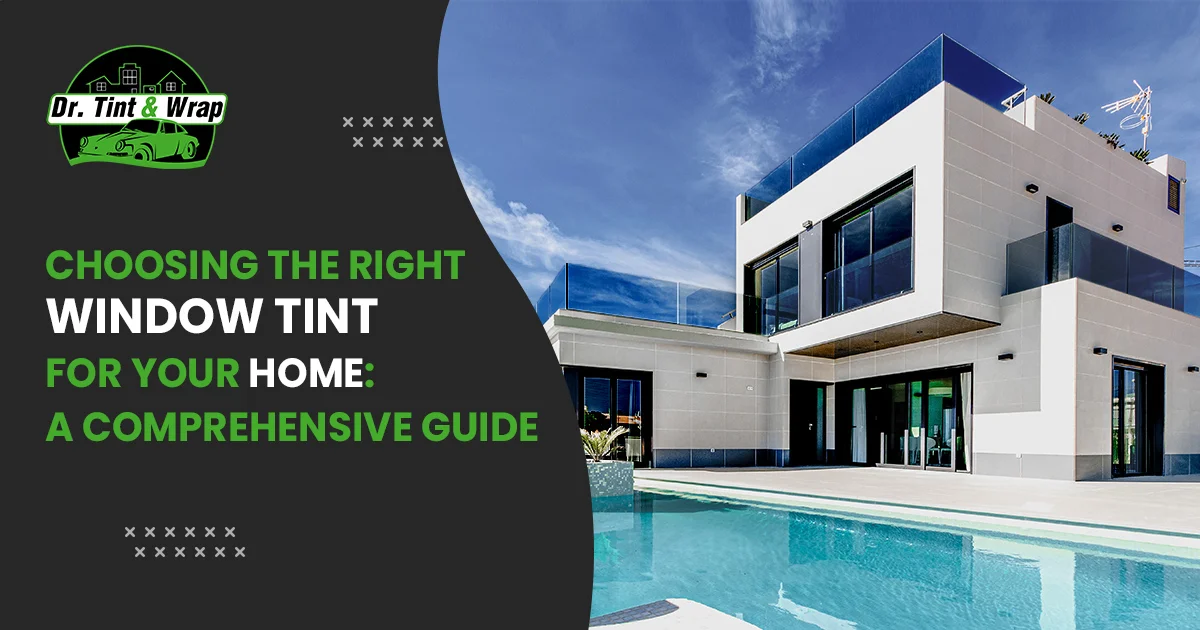
Choosing the Right Window Tint for Your Home: A 2023 Guide
23 Oct 2023, By AdminWhen it comes to enhancing the comfort, energy efficiency, and privacy of your home, window tinting is an excellent choice. In 2023, homeowners are increasingly turning to home window tinting not only for its aesthetic appeal but also for its practical benefits. However, choosing the right window tint for your home can be a daunting task with so many options available. To help you make an informed decision, this blog will answer some essential "wh" questions about home window tinting.
What is Home Window Tinting?
Home window tinting is a process where a thin film is applied to the interior or exterior surface of windows. This film contains various layers designed to provide specific benefits, such as reducing heat and glare, protecting against UV rays, and enhancing privacy.
Why Should You Consider Home Window Tinting?
a.What are the Benefits?
- Energy Efficiency: Window tinting helps regulate indoor temperatures, reducing the need for excessive heating or cooling.
- UV Protection: Tinted windows block harmful UV rays, preventing fading of furniture, flooring, and artwork.
- Glare Reduction: Tinting minimizes glare on screens and surfaces, making indoor spaces more comfortable.
- Privacy: Window films offer varying degrees of privacy, allowing you to control the visibility from outside.
b.How Does It Save Money?
- Reduced Energy Bills: By maintaining stable indoor temperatures, window tinting can lead to lower heating and cooling costs.
- Increased Lifespan of Furnishings: UV protection helps extend the lifespan of your interior furnishings, reducing replacement expenses.
When is the Best Time to Install Window Tinting?
The best time to install home window tinting is during the initial construction or renovation of your home. However, it can be added to existing windows at any time. It's essential to choose a reputable installer who can assess your needs and recommend the right time for installation.
Where Should You Apply Window Tinting?
You can apply window tinting to various areas in your home, including:
- Living rooms
- Bedrooms
- Bathrooms
- Kitchen
- Home offices
- Glass doors and skylights
Consider where you need specific benefits, such as glare reduction in your office or privacy in your bedroom.
How Do You Choose the Right Window Tint?
a.What are Your Goals?
- Identify your primary objectives, whether it's energy efficiency, UV protection, privacy, or all of the above.
b.Consider the Tint Type:,
There are different types of window tints to consider:
- Reflective Tint: Offers privacy and heat reduction but can be highly reflective from the outside.
- Ceramic Tint: Provides excellent UV protection and insulation without affecting visibility.
- Decorative Tint: Adds style and privacy with various patterns and designs.
c.Evaluate Tint Darkness:
- The darkness of the tint affects the amount of light and heat it blocks. Choose a darkness level that suits your preferences and needs.
d.Consult with Professionals:
- Seek advice from experienced window tinting professionals who can guide you in selecting the right tint for your home.
In 2023, home window tinting is a smart investment for any homeowner looking to improve energy efficiency, protect their furnishings, and enhance privacy. By answering the "wh" questions about home window tinting, we hope you're now better equipped to make an informed decision. Remember to consult with experts and consider your specific goals when choosing the right window tint for your home. With the right tint, you can enjoy a more comfortable, efficient, and private living space.

The Benefits of Home Window Tinting in New Zealand: Energy Efficiency and Cost Savings
23 Oct 2023, By AdminWhen it comes to enhancing the comfort and functionality of your home, window tinting is a solution that often goes unnoticed. In New Zealand, where climate variations are common, the benefits of home window tinting extend far beyond aesthetic appeal. In this article, we'll explore how home window tinting can significantly reduce your energy bills and lead to long-term cost savings, making it a smart investment for homeowners across the country.
Understanding the Energy Efficiency of Window Tinting
New Zealand experiences a range of weather conditions throughout the year, from scorching summers to chilly winters. During these extremes, the energy used to regulate indoor temperatures can skyrocket. This is where window tinting comes into play.
1. Heat Reduction: One of the primary benefits of window tinting is its ability to reduce heat gain. Tinted windows block a significant portion of the sun's heat and harmful UV rays from entering your home. As a result, your indoor spaces remain cooler during hot summer months, reducing the need for air conditioning.
2. Insulation: Window tinting also provides insulation benefits, helping to maintain a consistent indoor temperature. In winter, it helps to keep warmth inside, reducing the need for excessive heating.
Cost Savings Through Window Tinting
Now, let's delve into how these energy-efficient qualities translate into tangible cost savings for homeowners in New Zealand.
1. Lower Energy Bills: By reducing heat gain during the summer and heat loss during the winter, window tinting significantly reduces your reliance on heating and cooling systems. As a result, you'll see a noticeable drop in your energy bills year-round.
2. Extended Appliance Lifespan: Reduced reliance on air conditioners and heaters not only saves you money on electricity but also extends the lifespan of these appliances. They don't have to work as hard, which means fewer repairs and replacements.
3. Furniture and Flooring Preservation: Window tinting also blocks harmful UV rays that can cause fading and damage to your furniture, flooring, and décor. This means you won't have to spend as much on replacing or refurbishing these items.
4. Enhanced Home Value: A home with energy-efficient features like window tinting can command a higher resale value in the New Zealand real estate market. Potential buyers are often willing to pay more for a home with reduced energy costs.
In New Zealand, where energy efficiency and sustainability are becoming increasingly important, home window tinting stands out as a practical investment for homeowners. By reducing energy bills, extending the lifespan of appliances, preserving your interior, and enhancing your home's value, window tinting offers numerous long-term cost-saving benefits.
So, if you're looking to make your New Zealand home more energy-efficient and cost-effective, consider investing in professional window tinting services. Not only will you enjoy a more comfortable living space, but you'll also contribute to a greener and more sustainable future while saving money in the process.

Choosing the Right Window Tint for Your Home: A Comprehensive Guide
23 Oct 2023, By AdminWindows are the eyes of your home, providing natural light, ventilation, and a connection to the outside world. However, they can also be a source of problems, such as excessive heat, glare, and harmful UV rays. Window tinting offers a practical solution to these issues, but selecting the right window tint can be a daunting task. In this guide, we'll walk you through the process of choosing the appropriate window tint for your home based on your specific needs, climate, and window types.
1. Assess Your Needs:
Before diving into the world of window tinting, it's crucial to assess your specific requirements. Consider the following factors:
- Privacy: Do you need increased privacy without sacrificing natural light?
- Heat Reduction: Is your home excessively hot, especially during summer months?
- Glare Reduction: Do you struggle with glare from sunlight that affects your comfort and visibility?
- UV Protection: Are you concerned about fading furniture and flooring due to UV rays?
- Energy Efficiency: Are you looking to reduce energy costs by improving insulation?
2. Understand Different Types of Window Tints:
There are various types of window tints available, each designed to address specific issues:
- Solar Control Films: Ideal for heat and glare reduction, these films block UV rays and improve energy efficiency.
- Privacy Films: These tints provide privacy during the day while allowing natural light to enter your home.
- Security Films: Reinforce your windows for added security, protecting your home from break-ins and accidents.
- Decorative Films: Enhance aesthetics with decorative window films available in various patterns and designs.
3. Consider Your Climate:
The climate of your region plays a significant role in choosing the right window tint:
- Hot Climates: Opt for tints with high solar heat rejection and UV protection to keep your home cool and protect from sun damage.
- Cold Climates: Look for tints with insulating properties to retain indoor heat during winters, reducing heating costs.
4. Think About Window Types:
Different window types require different tinting solutions:
- Double-Pane Windows: Consult with a professional, as certain films can trap heat between the panes, potentially causing damage.
- Low-E Coated Windows: Use tints recommended by the window manufacturer to maintain the Low-E coating's effectiveness.
- Older Windows: Consider films that provide insulation, improving energy efficiency in older, less insulated windows.
5. Seek Professional Advice:
While there are DIY tinting kits available, consulting with a professional window tinting service is invaluable. They can assess your specific needs, recommend suitable products, and ensure proper installation, maximizing the tints' effectiveness and longevity.
6. Read Reviews and Get Samples:
Research online reviews and testimonials to learn about other homeowners' experiences with specific window tints. Additionally, request samples from manufacturers or service providers to physically see how different tints look and perform in your home environment.
7. Maintenance and Warranty:
Consider the maintenance requirements and warranty offered with the window tint. Some tints may require special cleaning methods to preserve their effectiveness, while others come with comprehensive warranties, ensuring long-term satisfaction.
In conclusion, choosing the right window tint for your home involves careful consideration of your specific needs, the climate you live in, and the types of windows you have. By understanding these factors and seeking professional guidance, you can enhance your home's comfort, energy efficiency, and overall aesthetics, making an informed choice that you'll appreciate for years to come.

Before You Spend Money on Ceramic Coatings, Here Are Some Things to Know
23 Oct 2023, By AdminWhen it comes to keeping your car looking brand new, one term that frequently pops up is ceramic coating. This innovative product has gained popularity among car enthusiasts for its ability to protect and enhance the appearance of your vehicle. But before you dive into the world of ceramic coatings, it's important to understand what you're investing in. Here's a comprehensive guide to help you make an informed decision.
What is Ceramic Coating?
Ceramic coating is a liquid polymer that is applied to the exterior of a vehicle. When cured, it chemically bonds with the factory paint, creating a layer of protection. This coating is often made from silicon dioxide (SiO2) and sometimes incorporates other compounds like titanium dioxide (TiO2) to enhance its protective properties.
The Benefits of Ceramic Coating
- Enhanced Protection: One of the primary reasons car owners opt for ceramic coating is its ability to protect the car’s paint from external contaminants. This includes protection against UV rays, bird droppings, tree sap, acid rain, and even minor scratches.
- Hydrophobic Properties: Ceramic coatings provide a hydrophobic layer, meaning water and other liquids bead off the surface easily. This makes cleaning your car much easier and can prevent water spots and staining.
- Glossy Finish: A high-quality ceramic coating will give your car a deep, glossy shine that can make it look better than new. This glossy finish is often one of the most attractive features for car enthusiasts.
- Durability: Unlike traditional waxes or sealants that may last only a few months, a properly applied ceramic coating can last for years. This longevity means less frequent reapplication and more consistent protection over time.
Things to Consider Before Getting a Ceramic Coating
- Cost: High-quality ceramic coatings can be expensive. The cost varies based on the brand, the condition of your car’s paint, and whether you opt for a professional application or a DIY kit. Professional applications can range from a few hundred to several thousand dollars.
- Preparation: Applying a ceramic coating is not a simple process. The car’s paint needs to be thoroughly cleaned and decontaminated, and in many cases, paint correction is necessary to remove any imperfections. This prep work can be time-consuming and requires skill.
- Maintenance: While ceramic coatings reduce the need for frequent waxing, they still require maintenance. You’ll need to wash your car regularly using the right products to maintain the coating’s effectiveness and appearance.
- Realistic Expectations: Ceramic coatings are not bulletproof. They can protect against minor scratches and contaminants but won’t make your car invincible. Large impacts, deep scratches, and harsh chemicals can still damage your vehicle's paint.
- Choosing the Right Product: The market is flooded with ceramic coating products, and not all are created equal. Research and read reviews to find a reputable brand. Some well-known brands include CarPro Cquartz, Gtechniq, and Chemical Guys.
DIY vs. Professional Application
- DIY Kits: There are many DIY ceramic coating kits available that can be applied at home. These kits are usually less expensive than professional applications but may not offer the same level of protection or longevity. Additionally, the application process can be tricky and requires careful attention to detail.
- Professional Application: Opting for a professional application ensures that the coating is applied correctly and evenly. Professionals have access to high-grade products and the necessary tools to prepare your car’s paint properly. While this option is more expensive, it often results in better, longer-lasting protection.
Final Thoughts
Ceramic coating can be a great investment for those looking to protect their vehicle and maintain its showroom shine. However, it’s crucial to weigh the costs, understand the application process, and have realistic expectations about what the coating can and cannot do. Whether you choose a DIY kit or go for a professional application, proper maintenance is key to getting the most out of your ceramic coating. Do your research, and your car will thank you for it.
Investing in a ceramic coating can save you time and money in the long run while keeping your car looking its best. Happy driving!
